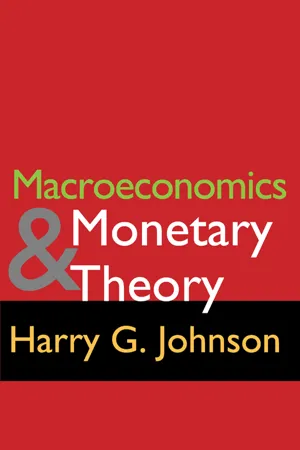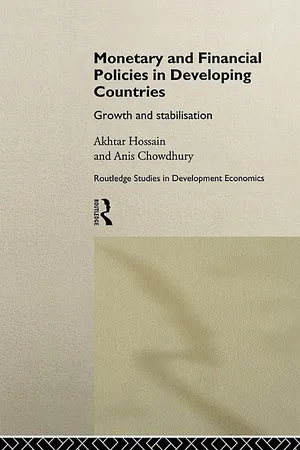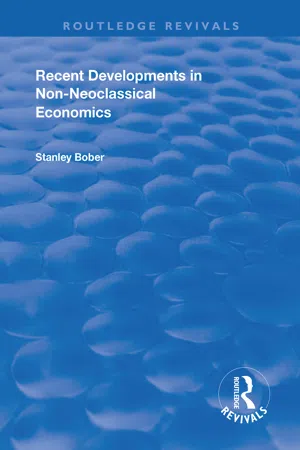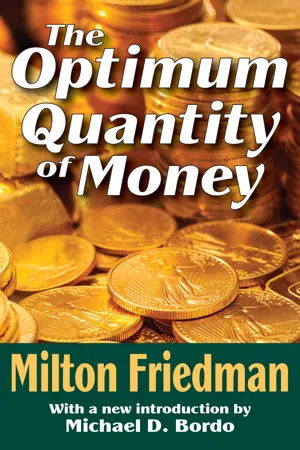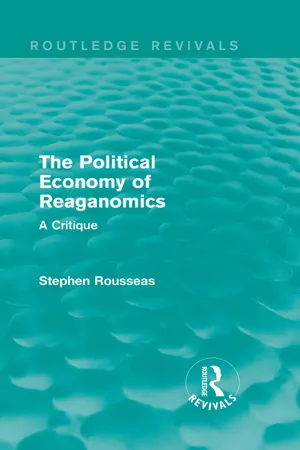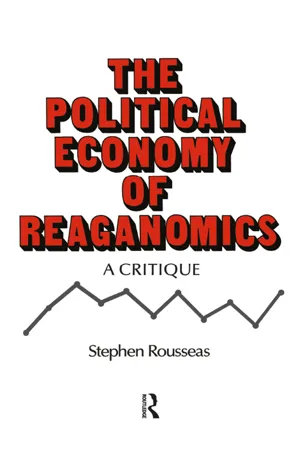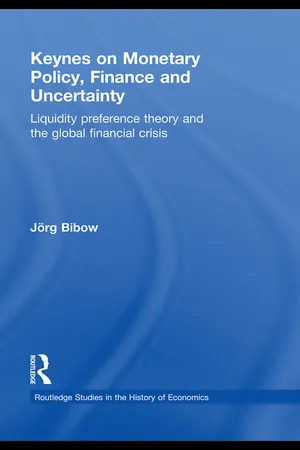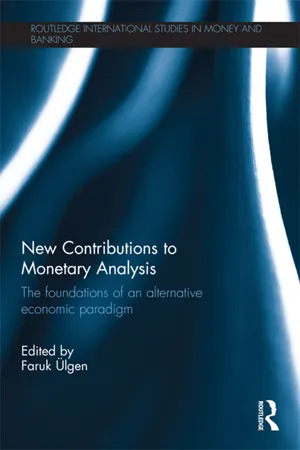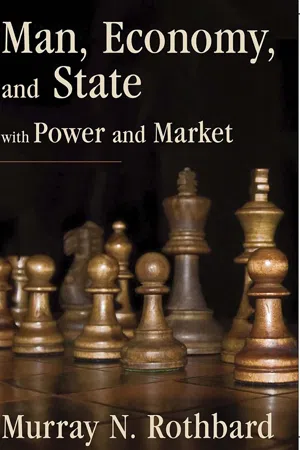Economics
Keynesian Demand for Money
Keynesian demand for money refers to the amount of money people want to hold for transactions and precautionary purposes. According to Keynesian economics, this demand is influenced by income and interest rates. As income rises, the demand for money also increases, while higher interest rates reduce the demand for money as people opt for alternative assets.
Written by Perlego with AI-assistance
Related key terms
Related key terms
1 of 4
Related key terms
1 of 3
11 Key excerpts on "Keynesian Demand for Money"
- eBook - ePub
- Harry G. Johnson(Author)
- 2017(Publication Date)
- Routledge(Publisher)
Treatise.) Analysis focuses on the choice between money and bonds. This choice determines the interest rate which, along with the marginal efficiency of capital, determines investment. Through the multiplier, investment determines income and employment. This way of presenting the theory is obviously defective. It is essentially a general equilibrium system, but Keynes initially presented it as a theory of one-way causation from money to interest rates to income.The Keynesian-Neoclassical Split
According to neoclassical writers the demand for and supply of money determined its purchasing power. In Keynesian theory, the demand and supply of money determine the interest rate. Money is not viewed as a commodity but as an asset with a price relative to other assets given by the cost of holding money, i.e. the rate of interest. The ‘price’ of money is not the reciprocal of the average money prices of other things, but the rate of interest foregone in holding it.Determinants of Demand for Money in Keynes
Keynes formulated the demand for money chiefly in terms of two groups of motives which determine how much money will be held at a given rate of interest. This corresponds to the two functions of money as a medium of exchange and a store of value.In dealing with the transaction demand, Keynes was extremely conventional and applied a crude quantity theory approach. Transactions demands were explained by the income and business motives. The income motive would bridge the interval between receipt of income and expenditure (which depended mainly on the amount of income and the length of time between income payments). The business motive bridged the gap between incurring business costs and receiving sales revenue. Robertson pointed out that this is precisely the time that money is not held. The business motive in fact depends on the value of output and degree of integration of the economy whereas the attractions of holding money for business or other transactions depends in part on the cost of borrowing money and the return on cash holding (i.e. interest on bank deposits). Keynes disregarded these in the operational formulations of his theory in which the transaction demand was a constant proportion of income. - eBook - ePub
- Rousseas(Author)
- 2016(Publication Date)
- Routledge(Publisher)
CHAPTER 3 The demand for money and the rate of interestThe exogenous money supply
Within traditional Keynesian economics money serves as a means of payment and a store of wealth. These two functions of money were used by Keynes to undermine the classical dichotomy between the real and monetary sectors of the economy. The end result was his liquidity preference theory of the demand for money which allowed changes in the monetary sector to be transmitted to the real sector through changes in the rate of interest. But Keynes also assumed, along with everyone else, that the supply of money was exogenously determined. An exogenous money supply is simply another way of saying that the central bank (through its use of open market operations, the discount rate, and reserve requirements) can adjust the overall volume of money, in response to changes in the demand for it, to that level consistent with its policy objectives.In a tight money situation, neoclassical Keynesian analysis, as we shall see, did allow that certain short-run leakages could occur, via changes in the income velocity of money in response to interest-rate changes, that would tend to undermine the effectiveness of a monetary policy operating directly on the supply side. Such leakages, however, were believed to play themselves out quickly, allowing the full effectiveness of monetary policy to take hold in sufficient time to achieve the policy objectives of the monetary authorities. Monetarists, on the other hand, deny that the central bank can effectively use discretionary monetary policy in the short run. The variable lags of monetary policy, in conjunction with the inability of anyone to locate the actual position of the economy on the business cycle, at any particular moment of time, make it impossible, according to the monetarists, for the central bank to control the exogenous money supply in a contracyclical manner. Indeed, central bank policies are notoriously perverse in achieving ex post what was not intended. For monetarists the only sensible thing to do is to ignore the short-run business cycle altogether and play for the long run. The greatest contribution the central bank can make, in their view, is to allow the money supply (which is presumed to have a stable relationship to the monetary base, i.e., the sum of bank reserves and currency in circulation) to increase mechanically at the natural, long-term growth rate of the economy adjusted for the secular decline in the income velocity of money—the famous "monetary rule." But whether one opts for the monetarist rule or the Keynesian use of short-run discretionary monetary policy with the rate of interest as its target, the fact remains that both - Anis Chowdhury, Akhtar Hossain(Authors)
- 2003(Publication Date)
- Routledge(Publisher)
2 Keynes’s liquidity preference theory suggests that people hold cash in order to take advantage of fluctuations in bond prices. For example, when bond prices are low (interest rates are high), people buy bonds and hold less cash balances and vice versa. Therefore, it follows that when money supply increases, people get rid of excess cash by buying bonds and thereby drive the bond prices up (i.e. interest rates down). The lower interest rate induces more investment and hence higher output. Schematically,where r is the real interest rate and I is investment.Thus, in the Keynesian model, the money supply affects real output via the interest rate and investment. It makes the impact of monetary policy uncertain. In this scheme the reliability of monetary policy depends on the impact of excess money supply on the interest rate, changes in investment in response to changes in the interest rate and the value of the expenditure multiplier. If the demand for money is such that people keep the entire excess money supply as cash balances, then there will be no impact on the interest rate and output will remain unchanged.3 Thus, it is important to know the demand for money in order to predict any change in the interest rate as a result of changes in the money supply.The interest rate or the cost of fund is only one, but an important, factor that influences investment decisions. If other factors, such as future profitability, dominate investment decisions, then changes in the interest rate may not have any significant impact on investment spending. Again, changes in investment will not result in large changes in output if the expenditure multiplier is small. A small expenditure multiplier can result from a high marginal propensity to save, a high marginal propensity to import, and a high tax rate.- Stanley Bober(Author)
- 2019(Publication Date)
- Routledge(Publisher)
If the only reason for holding some proportion of nominal income in the form of money is that it is a transaction tool, then a change in that proportion will be inverse to the value of money which itself depends on the variation of its supply. The play is to reckon that a change in the money supply solves for the price level which is mirrored in the change in the demand to hold money. Should the money supply be taken as ‘fixed’, then price changes would emanate from a change in the demand coefficient which we supposed, however, to be motivated by the price change itself. Though one could venture some socio-political reasons that would cause changes in money demand; the center of attention in this context of the singular money demand factor is the supply of money. And coming to the central point of pre-Keynesian classical approach (it seems that Keynes referred to all that came before him as ‘classical’): it is that exogenous changes in the money supply will result in an equiproportional change in the price level without changing the level of real output and employment or the rate of interest, i.e. the rate of profit in terms of the long-run vision. So our lack of attention to money in analyzing the steady-state behavior of the real variables would seem to be of no great loss. Quite possibly, the classical model, with some changes in design, would fit well with the post-Key nesian emphasis on the long-term behavior of the economy.Though before reaching any conclusion let us briefly set out the mechanics of this ‘classical-with expectations’ model; we append the expectations term because the supply curve of labor within this approach is more realistically designed on an expectations base. At the heart of this analysis is the operation of a labor market which fails to transmit a change in aggregate demand and prices — say due to monetary disturbances — to a change in employment and real output.- eBook - ePub
- Milton Friedman(Author)
- 2017(Publication Date)
- Routledge(Publisher)
7Interest Rates and the Demand for MoneyONE MAJOR STRAND of Keynesian analysis traces the implications of a particular empirical assumption about the demand for money—that its elasticity with respect to interest rates is very high, approaching infinity (in Keynes’ own terms, liquidity preference is, if not absolute, approximately so). Such a situation would have very far-reaching implications: it would greatly limit the effectiveness of price flexibility in correcting unemployment; it would render changes in the quantity of money produced by open market operations impotent to affect economic conditions; it would make the effect of government deficits on income and employment independent of the way in which the deficits are financed.By now, there is wide agreement that conditions of near-absolute liquidity preference, if they occur at all, are very rare, so that this strand of Keynesian analysis has receded to the status of a theoretical curiosity.More recently, a number of economists have attributed major theoretical importance to the opposite empirical assumption about the demand for money—that its elasticity with respect to interest rates is negligible. Such a situation, they assert, would have far-reaching implications for the theoretical possibility of separating monetary and real forces and for monetary policy.Like Keynes’ analysis, these assertions raise two separable issues. One issue is empirical: What is the elasticity of the demand for one or another monetary total with respect to various interest rates? How stable is the relation between the (real) quantity of money demanded and interest rates, for both different monetary totals and different interest rates? How consistent are the elasticities for different periods and countries? How important are interest rates compared with other variables in explaining changes in the quantity of money demanded? The other issue is theoretical : Would a highly inelastic demand for money with respect to interest rates have the far-reaching implications alleged? - eBook - ePub
The Political Economy of Reaganomics
A Critique
- Stephen Rousseas(Author)
- 2015(Publication Date)
- Routledge(Publisher)
Chapter 3 Demand-Side Economics *I
In preparation for the monetarist version of supply-side economics, the orthodox quantity theory of money will be briefly outlined and compared with prevailing demand-side theories of our time, namely, the Keynesian theory of output and employment and Milton Friedman's variation on the same theme. The exposition, though necessarily sketchy and overly simplified, will serve as background for the chapters to follow.The traditional quantity theory of money has a long history going back, at least, to the eighteenth and nineteenth centuries. It states that the total output of goods and services produced in an economy, within any given period of time (for example, one year), can be expressed in two equivalent ways. From the "goods" side, total nominal output (Y ) is simply the sum of all goods produced in that period multiplied by their respective market prices, i.e., Y=PQ, where Q is the total real output of goods and services and P is the general price level consisting of the set of individual prices relevant to the myriad components of Q. Alternatively, from the "money" side, this is equivalent to the aggregate money supply (M ) multiplied by the average number of times each unit of money turns over in a year's time, i.e., the income velocity of money (V ). In short, Y =MV If Y=PQ and Y=MV , then it follows thatMV=PQThis is the quantity equation of exchange. It is a tautology that describes two sides of the same coin. Clearly, if the total stock of money is $500 billion and each dollar turns over, on the average, 6 times a year, then national income is 500 x 6 or $3 trillion—which is another way of describing the total amount of real output in nominal terms, where each unit of real output is valued at its respective market price.The quantity equation of exchange can be transformed into the quantity theory of money by introducing two behavioral assumptions plus a causal arrow. First, it is assumed that in a perfectly competitive market system real output in the long run is always at full employment. Short-run deviations from full employment can only be temporary; they are quickly corrected by the automatic forces of the market system. For all intents and purposes, therefore, Q can be taken as given. Next, the rate of turnover of the money supply is determined by the institutional arrangements of the financial system. The underlying financial structure of the economy, it is assumed, changes very slowly over the secular long run. Therefore, V can also be taken as given. With Q and V given, the theory now states that a one-way causal arrow exists which indicates that prices (P ) respond to changes in the money supply (M), not - eBook - ePub
- Stephen Rousseas(Author)
- 2023(Publication Date)
- Routledge(Publisher)
CHAPTER 3Demand-Side Economics*I
In preparation for the monetarist version of supply-side economics, the orthodox quantity theory of money will be briefly outlined and compared with prevailing demand-side theories of our time, namely, the Keynesian theory of output and employment and Milton Friedman’s variation on the same theme. The exposition, though necessarily sketchy and overly simplified, will serve as background for the chapters to follow.The traditional quantity theory of money has a long history going back, at least, to the eighteenth and nineteenth centuries. It states that the total output of goods and services produced in an economy, within any given period of time (for example, one year), can be expressed in two equivalent ways. From the “goods” side, total nominal output (Y) is simply the sum of all goods produced in that period multiplied by their respective market prices, i.e., Y = PQ, where Q is the total real output of goods and services and P is the general price level consisting of the set of individual prices relevant to the myriad components of Q. Alternatively, from the “money” side, this is equivalent to the aggregate money supply (M) multiplied by the average number of times each unit of money turns over in a year’s time, i.e., the income velocity of money (V). In short, Y = MV. If Y = PQ and Y = MV, then it follows thatM V = P QThis is the quantity equation of exchange. It is a tautology that describes two sides of the same coin. Clearly, if the total stock of money is $500 billion and each dollar turns over, on the average, 6 times a year, then national income is 500 × 6 or $3 trillion—which is another way of describing the total amount of real output in nominal terms, where each unit of real output is valued at its respective market price.The quantity equation of exchange can be transformed into the quantity theory of money by introducing two behavioral assumptions plus a causal arrow. First, it is assumed that in a perfectly competitive market system real output in the long run is always at full employment. Short-run deviations from full employment can only be temporary; they are quickly corrected by the automatic forces of the market system. For all intents and purposes, therefore, Q can be taken as given. Next, the rate of turnover of the money supply is determined by the institutional arrangements of the financial system. The underlying financial structure of the economy, it is assumed, changes very slowly over the secular long run. Therefore, V can also be taken as given. With Q and V given, the theory now states that a one-way causal arrow exists which indicates that prices (P) respond to changes in the money supply (M), not - Jorg Bibow(Author)
- 2013(Publication Date)
- Routledge(Publisher)
not invalidate this apparatus. Rather, it highlights the important role of financial intermediaries in a changing and growing economy.I should warn the reader that the chapter abstracts from the uncertainty aspects central to liquidity preference theory, and that I shall not directly address the related “endogenous money” debate. As the title suggests, what follow are first of all reflections on a motive for the demand for money.42.2 The transactions motive for the demand for money
Keynes distinguishes between three different motives for holding money in The General Theory: the transactions motive, the precautionary motive and the speculative motive. I shall here concentrate on the transactions motive, which Keynes further divides into the “income-motive” and the “business-motive,” relating to income-recipients in general and to businesspeople and dealers respectively. Both sub-categories of the transactions motive arise out of the imperfect synchronization of receipts and payments. Money, i.e. bank deposits, held (primarily) to satisfy the transactions motive serves to bridge the intervals between incoming and outgoing payments. The strength of this motive, Keynes argues, depends on various mainly institutional factors such as, for example, the length of the period between income payments, the structure and organization of industry, the value of current output, the cheapness and reliability of methods of obtaining cash when it is required and, to some extent, on the relative cost of holding cash (cf. Keynes 1936a, JMK 7: 195–6).It is partly due to Keynes’ (static) short-period equilibrium method in The General Theory, tailored to “discover what determines at any time the national income of a given economic system and … the amount of its employment” (Keynes 1936a, JMK 7:247), that sight is sometimes lost of the fact that these transactions deposits are held and reconstituted to finance expenditures (or rather transactions in general). Another reason is that the discussion of the transactions motive in The General Theory is clearly only a sketch of the elaborate analysis of the “cash deposits” Keynes presents in his earlier Treatise on Money, and which he thought unnecessary to repeat in much detail.5- eBook - ePub
- Faruk Ülgen, Ramon Tortajada, Matthieu Méaulle, Rémi Stellian(Authors)
- 2013(Publication Date)
- Routledge(Publisher)
In the first section, we shall namely observe that the principle of effective demand falls within a theory of the monetary economy of production. Further, in the next section, we shall oppose Keynes's definition of the production factors to Walras's definition. This opposition is a complementary evidence of the continuity of Keynes's plans. In the final section, continuity will also be checked with reference to the monetary analysis Keynes developed earlier in this Treatise on Money (1930) and later on in his “Proposals for an International Clearing Union” (1941–3). The principle of effective demand as a core component of a theory of the monetary economy of production It is worth recalling that in the neoclassical representation, which Keynes labeled a “real exchange economy,” firms are mere intermediaries between the market for productive services and the market for produced goods. Solving what he terms “the equations of production,” Walras came to the conclusion that the equilibrium position of markets is achieved when supply equals demand for each service and product, and when “the selling prices of the products [are] equal to the cost of the services employed in making them” (Walras 1874/1954: 253–4). Fundamentally, productive services exchange for goods, and money intervenes as a neutral medium of exchange. The exchange of productive services for goods even boils down to the exchange of productive services for one another, and firms and money may be disregarded: [W]ith exchange and production in a state of equilibrium we may abstract, if not from numéraire, at least from money, provided that the land-owners, labourers and capitalists receive from the entrepreneurs a certain quantity of products in the form of rent, wages and interest in exchange for a certain quantity of productive services in the form of land-services, labour and capital-services - eBook - ePub
- Murray N(Author)
- 2014(Publication Date)
- Editorial Bubok Publishing(Publisher)
The Purchasing Power of Money (2nd ed.; New York: Macmillan & Co., 1913).4 A typical such classification can be found in Lester V. Chandler, An Introduction to Monetary Theory (New York: Harper & Bros., 1940).5 See Mises, Theory of Money and Credit , p. 98. The entire volume is indispensable for the analysis of money. Also see Mises, Human Action, chap. xvii and chap. xx.6 See chapter 12 below for a discussion of the concept of social benefit or social utility.7 J.M. Keynes’ Treatise on Money (New York: Harcourt, Brace, 1930) is a classic example of this type of analysis.8 On the clearing system, see Mises, Theory of Money and Credit , pp. 281–86.9 Since no one can receive a money income unless someone else makes a money expenditure on his services. (See chapter 3 above.)10 Strictly, the ceteris paribus condition will tend to be violated. An increased demand for money tends to lower money prices and will therefore lower money costs of gold mining. This will stimulate gold mining production until the interest return on mining is again the same as in other industries. Thus, the increased demand for money will also call forth new money to meet the demand. A decreased demand for money will raise money costs of gold mining and at least lower the rate of new production. It will not actually decrease the total money stock unless the new production rate falls below the wear-and-tear rate. Cf. Jacques Rueff, “The Fallacies of Lord Keynes’ General Theory” in Henry Hazlitt, ed., The Critics of Keynesian Economics (Princeton, N.J.: D. Van Nostrand, 1960), pp. 238–63.11 See the excellent article by W.H. Hutt, “The Significance of Price Flexibility” in Hazlitt, Critics of Keynseian Economics , pp. 383–406.12 - eBook - ePub
- Robert E. Lucas Jr., Max Gillman, Max Gillman(Authors)
- 2013(Publication Date)
- Harvard University Press(Publisher)
11Money Demand in the United States: A Quantitative Review
I. Introduction
Allan Meltzer’s research career has been so productive and so varied that it would be an act of folly, not friendship, to attempt to review it in a single paper. Yet I do want to talk about his research on this occasion, for research is what Allan’s career is mainly about, and I want to do so in detail, because details are the way scholarship is carried out. Accordingly, I will focus my attention mainly on a single paper, one that has influenced my own thinking on monetary economics a great deal, Meltzer’s “The Demand for Money: The Evidence from Time Series,” published in the Journal of Political Economy in 1963.Meltzer’s “Demand for Money” was one in a series of his empirical studies in monetary economics, much of which involved joint research with Karl Brunner. It followed earlier work by Latane and others, especially Friedman, and helped to stimulate closely related later contributions by Laidler and others.1 The shared objective of this research program was, in Friedman’s (1956) terms, to demonstrate that the demand for money is a “highly stable function” of a limited number of variables, to discover the most useful, operational measures of money and these other variables, and (again citing Friedman) to work “toward isolating the numerical ‘constants’ of monetary behavior.” Meltzer’s paper was the first to estimate an income (or wealth) elasticity and an interest elasticity simultaneously from time series data from a single country (the U.S.). The objective of the present paper will be to review and replicate these results, to reconsider how they might be interpreted theoretically, and to see how well they stand up to the 25 years of new data that have become available since Meltzer wrote.An estimated money demand function provides answers to two important questions of economic policy. The income elasticity, in a setting in which long run real output growth is both fairly predictable and insensitive to changes in monetary policy, provides the answer to the question: What rate of growth of money is consistent with long run price stability? The interest elasticity is the key parameter needed to answer the question: What are the welfare costs to society of deviations from long run price stability? Purely qualitative answers to these questions, along the lines of “Inflation rates are significantly related to money growth rates” or “Inflation reduces welfare” are interesting and useful, perhaps, but surely propositions such as “An M
Index pages curate the most relevant extracts from our library of academic textbooks. They’ve been created using an in-house natural language model (NLM), each adding context and meaning to key research topics.
Explore more topic indexes
Explore more topic indexes
1 of 6
Explore more topic indexes
1 of 4
